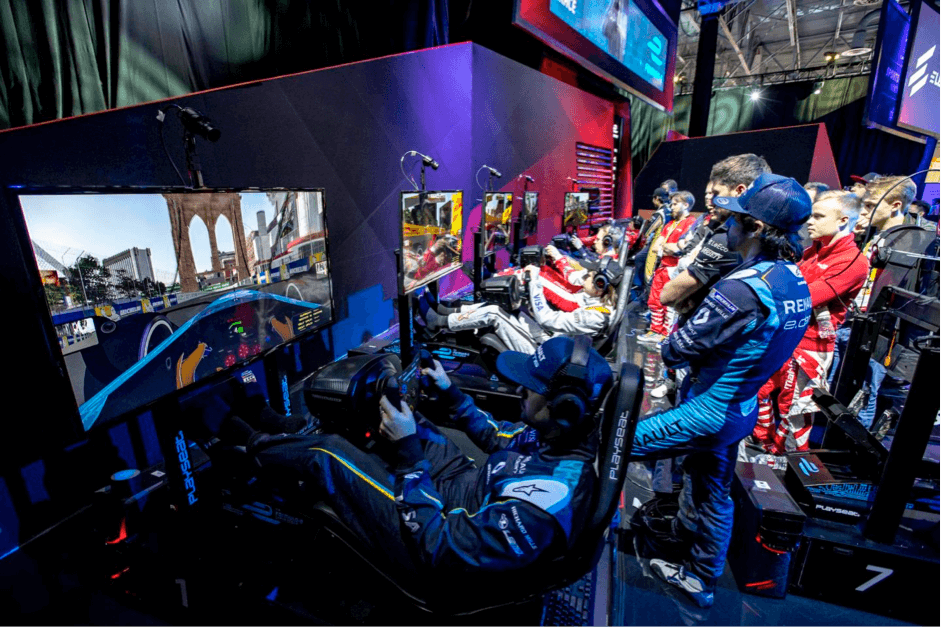Last year was a particularly good one for eSports. Despite many sports industry stakeholders continuing to muse over whether gaming actually constitutes a sport, whether the new arrivals threatened to steal food from their table, and perhaps most importantly whether its meteoric rise represented a ticking time-bomb for future generations’ health, the eSports fraternity has wasted no time in getting its cleverly re-branded feet firmly under the Sports Industry table.
And already this new proximity has started to bear fruit…
In the past week, a couple of stories have come to light which show how eSports, or virtual sporting worlds, and ‘traditional’ sports can work effectively in tandem for demonstrably mutual benefit – helping sports shape future product development, enabling them to reach a new audience and at the same time offering the gaming world a host of exciting new opportunities.
Last weekend, Las Vegas’ CES hosted the first-ever Visa Vegas eRace, which saw all 20 current Formula E drivers line up against 10 sim racers, including Scot Graham Carroll, 26, a former British and Scottish national racing champion, whose career was cut short by the exorbitant costs of motor racing professionally. They raced on a bespoke track, incorporating the famous Las Vegas strip, for the opportunity to win a share of $1million – the biggest prize in eSports racing history. A dutch gamer, Bono Huis, presided but interestingly the top ten finishers were split equally between gamers and professional drivers.
The concept of video games providing a conduit for amateurs from virtual proficiency to the professional ranks is not a new one, as Nissan’s GT Academy has run successfully for 8 years, and now provides a pathway to professional motorsport to no fewer than 21 gamers.
Another meeting of the virtual and professional worlds last week saw the Canyon/SRAM cycle racing team awarding a pro contract to 37-year-old amateur cyclist, Leah Thorvilson, the winner of the 2016 Zwift Academy. Zwift is an online game played by cyclists to spice up life on their turbo trainer and Thorvilson was selected to race for the pro team from 1,200 global competitors, having made a major impression on the judges with the performance data gathered from her indoor training.
Our behavioural research project The Future of the Sports Fan showed that 28% of fans wanted to see sponsors actively bringing them closer to the professional world, and emerging technology is providing ever more opportunities to do this.
Last year, we created our own bridge between the amateur and professional worlds on behalf of Fiat Professional through the Tradesman Trials, which gamified the football scouting process. The activity saw River Humphreys, 25, win a one month trial with Rochdale AFC having replicated FIFA-like skills to produce an eye-catching video the judges couldn’t ignore, and then followed through with an impressive performance in person on trials day.
A key finding from our Future Fan research was that Gens Y & Z are increasingly frustrated and alienated by the offerings from mainstream sport. Their touchscreen upbringing has produced an expectation of interaction with and the ability to affect outcomes, rather than just watch. Innovative projects like Formula E’s Fanboost are the perfect antidote to this. But even sports with longer heritage should take note – and every sport could do a lot worse than ask themselves whether their product would make for a good video game.
And if not, why not, and what would have to be done to change that.
The enterprising introduction of Sprint 6 Golf and its potential inclusion on the European Tour’s schedule is an example of how a sport’s ‘traditional’ (72-hole) product can be ‘gamified’ to appeal to a new audience and broaden the sport’s church.
A challenge common to many sports is how to reduce the average age of its fan base, and taking an esports approach could help make that happen.
For example, the average age of a triathlete is 42, but its elite stars are young. What would a Brownlees video game look like? Might it resemble the mixed relay format trialled at the Commonwealth Games and under consideration for inclusion at Tokyo 2020? Sailing also has an older fanbase, but the much lauded TV coverage of America’s Cup 34 borrowed heavily from video games. It is easy to imagine a video game which would bring the match racing skippering challenges to life for a non-sailing audience.
Now eSports is at the table, sporting stakeholders need to take advantage of the different perspective gaming offers onto their product and also, through cooperation, seek to capitalise on the gateway to attractive new audiences.
















